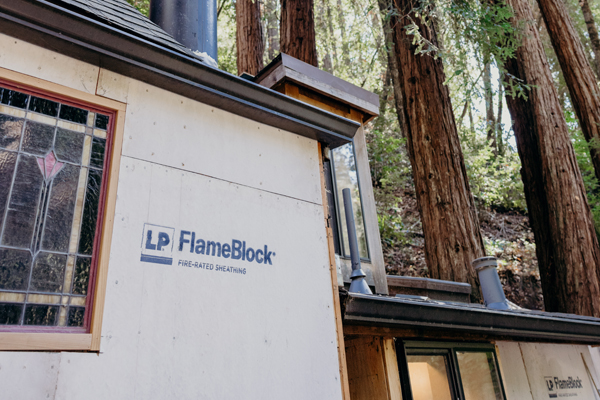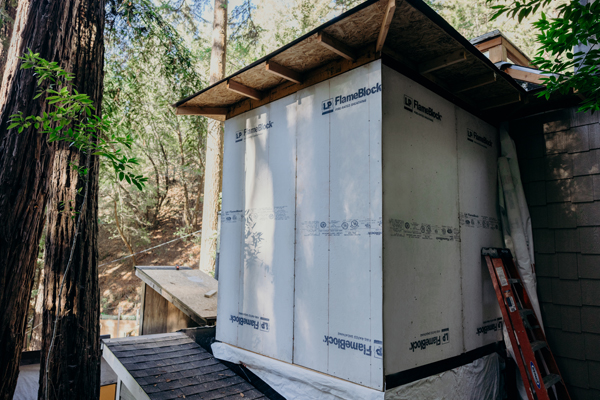Business Advice8 min
How to Use Fire-Rated OSB Sheathing: Advice From the Pros
Building to code is critical—and though it may feel like a daunting task that eats away at time, it’s what may protect your structure and, ultimately, your clients. Luckily there are smart product solutions like LP® FlameBlock® Fire-Rated Sheathing that make fire-resistant construction easier to take on.
To help us understand the true value of LP FlameBlock sheathing, we asked Scott Johnson, LP Building Solutions Construction Services Manager, and Casey Smyth, LP Structural Solutions Brand Manager, to weigh in.
Keep reading to find out how to use fire-rated OSB sheathing for more efficient home design.
Why do builders reach for LP FlameBlock Fire-Rated Sheathing?
“If you’re going to build a house or structure that requires some sort of fire-resistant construction, ideally you want a system that is cost effective, efficient and meets the code requirements. In my experience, LP FlameBlock sheathing does just that,” says Johnson.
LP FlameBlock Fire-Rated Sheathing is a single-sheet solution made of APA-rated OSB sheathing paired with a noncombustible Pyrotite® coating. It doesn’t just offer builders a smart solution; it can also provide homeowners with added peace of mind and protection.
Where can LP FlameBlock sheathing be used?
“The codes in your areas may prescribe use of materials like LP FlameBlock sheathing. For instance, homes in areas prone to wildfires can benefit from using LP FlameBlock panels,” says Johnson.
LP FlameBlock sheathing helps provide a fire-resistant layer behind the exterior cladding, helping to protect the building’s structure.
“Even in places without a requirement, it’s a good way to offer some fire resistance on your exterior sheathing—especially in wildfire zones,” adds Smyth. Think of dry, woodsy or grassland areas, like parts of California, Florida, Texas and Arizona.

What are some of the most noticeable fire-rated sheathing benefits on the jobsite?
“One of the biggest benefits of LP FlameBlock sheathing is that it shouldn’t change anything in terms of what you’d normally do,” says Johnson. “It’s a wood structural panel that has fire resistance characteristics.”
Can it be used on multifamily and other light framed structures?
LP FlameBlock sheathing is evaluated by ICC-ES as a component of 1- and 2-hour fire-rated wall assemblies and roof deck applications. Its most common use is for 1-hour and 2-hour fire-resistance-rated wall assemblies with wood and metal stud framing. Often LP FlameBlock wall assemblies may eliminate some or all exterior gypsum, which can create thinner wall assemblies.
In addition to single-family homes, you can find different applications of LP FlameBlock sheathing that may be suitable for townhome separations and mid-rise construction. Scroll through a complete list of LP’s 50-plus assemblies to choose from or see our guide to LP FlameBlock assemblies here.
How does LP FlameBlock sheathing work with other products in the LP® Structural Solutions portfolio?

“The whole LP Structural Solutions portfolio is really designed to work well together,” adds Smyth.
LP FlameBlock Fire-Rated Sheathing helps meet building code requirements while working with the other products in the LP Structural Solutions portfolio to Defend Your Build®.
Curious what other pros have to say about LP Structural Solutions products? Check out part one and two of the Design a House with the Pros series.
Continue Reading
Resiliency Solutions
5 minIntroducing LP® SmartSide® ExpertFinish® Naturals Collection™: Nature-Inspired Beauty Meets Engineered Performance
We’re excited to introduce the LP® SmartSide® ExpertFinish® Naturals Collection™, a bold new addition to our trusted line of engineered wood siding and trim that delivers the warmth and beauty of nature with the advanced protection and performance builders and homeowners expect.
Labor Solutions
5 minChoosing the Right LP® Structural Solutions Product for Your Build
When it comes to building strong, reliable, and high-performing structures, the materials you choose matter. At LP Building Solutions, we understand that every project, whether it’s a single-family home or a multifamily development, requires structural components that meet your needs for strength, durability, and efficiency.
Sustainability Solutions
5 minBuilding a More Sustainable Future with LP Building Solutions
In today’s world, sustainability is no longer just a buzzword, it’s a blueprint for responsible living and smarter building. As the construction industry seeks ways to reduce its environmental footprint, LP Building Solutions is focused on providing innovative building materials for eco-conscious builders to help reshape what it means to build sustainably
News & Stories3 min
History of Partnership with Gary Sinise Foundation
The LP Foundation is a proud partner of the Gary Sinise Foundation, which supports wounded veterans in several ways. You can learn more about the LP Foundation here.